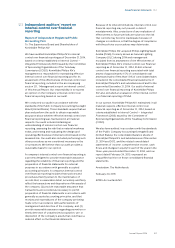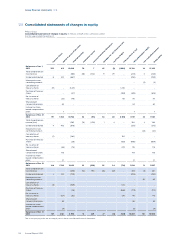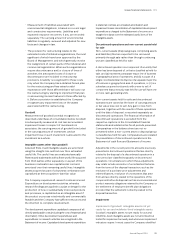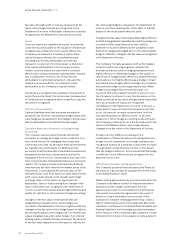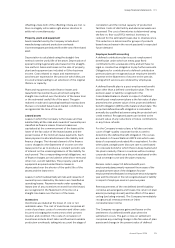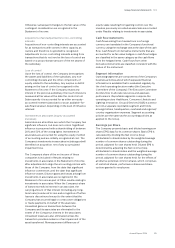Philips 2014 Annual Report Download - page 115
Download and view the complete annual report
Please find page 115 of the 2014 Philips annual report below. You can navigate through the pages in the report by either clicking on the pages listed below, or by using the keyword search tool below to find specific information within the annual report.
1Group nancial statements 12.9
Annual Report 2014 115
12.9 Notes
Separation - HealthTech and Lighting Solutions
In September 2014 Philips announced its plan to
sharpen its strategic focus by establishing two stand-
alone companies focused on the HealthTech and
Lighting Solutions opportunities.
To achieve this transformation, from January 1, 2015,
Philips started to integrate the sectors Consumer
Lifestyle and Healthcare into one operating company
focused on our HealthTech businesses. At the same
time Philips is taking the next step in the
implementation of its new operating model which will
give the company a dedicated, focused and lean
management structure, as a result of the planned
integration of the relevant sector and group layers.
The establishment of the two stand-alone companies
will also involve the split and allocation of the current
Innovation, Group & Services sector to each company
in 2015. This means that in the course of 2015 the IG&S
sector as currently described in these nancial
statements will disappear and no longer be presented
as a separate segment for reporting purposes.
Philips also started the process to carve out its Lighting
business into a separate legal structure and will
consider various options for ownership structures with
direct access to capital markets. The proposed
separation of the Lighting business impacts all
businesses and markets as well as all supporting
functions and all assets and liabilities of the Group and
may require complex and time consuming
disentanglement eorts.
Prior-period restatements
Prior-period nancial statements have been restated
for the treatment of the combined businesses of
Lumileds and Automotive as discontinued operations
(see note 3, Discontinued operations and other assets
classied as held for sale) and for two voluntary
accounting policy changes (see note 1, Signicant
accounting policies). Movement schedules of balance
sheet items include items from continuing and
discontinued operations and therefore cannot be
reconciled to income from continuing operations and
cash ow from continuing operations only.
Notes to the Consolidated nancial statements
of the Philips Group
1Signicant accounting policies
The Consolidated nancial statements in the Group
nancial statements section have been prepared in
accordance with International Financial Reporting
Standards (IFRS) as endorsed by the European Union
(EU) and with the statutory provisions of Part 9, Book 2
of the Dutch Civil Code. All standards and
interpretations issued by the International Accounting
Standards Board (IASB) and the IFRS Interpretations
Committee eective year-end 2014 have been
endorsed by the EU, except that the EU did not adopt
some of the paragraphs of IAS 39 applicable to certain
hedge transactions. Koninklijke Philips N.V. (hereafter:
the ‘Company’ or ‘Philips’) has no hedge transactions to
which these paragraphs are applicable. Consequently,
the accounting policies applied by Philips also comply
with IFRS as issued by the IASB. These accounting
policies have been applied by group entities.
The Consolidated nancial statements have been
prepared under the historical cost convention, unless
otherwise indicated. The Consolidated nancial
statements are presented in euros, which is the
Company’s presentation currency.
On February 24, 2015, the Board of Management authorized
the Consolidated financial statements for issue. The
Consolidated financial statements as presented in this report
are subject to adoption by the Annual General Meeting of
Shareholders, to be held on May 7, 2015.
Use of estimates
The preparation of the Consolidated financial statements in
conformity with IFRS requires management to make
judgments, estimates and assumptions that affect the
application of accounting policies and the reported amounts
of assets, liabilities, income and expenses. These estimates
inherently contain a degree of uncertainty. Actual results may
differ from these estimates under different assumptions or
conditions.
These estimates and assumptions affect the reported
amounts of assets and liabilities, the disclosure of contingent
liabilities at the date of the Consolidated financial
statements, and the reported amounts of revenues and
expenses during the reporting period. We evaluate these
estimates and judgments on an ongoing basis and base our
estimates on historical experience, current and expected
future outcomes, third-party evaluations and various other
assumptions that we believe are reasonable under the
circumstances. The results of these estimates form the basis
for making judgments about the carrying values of assets and
liabilities as well as identifying and assessing the accounting
treatment with respect to commitments and contingencies.
We revise material estimates if changes occur in the
circumstances or there is new information or experience on
which an estimate was or can be based.
The areas where the most signicant judgments and
estimates are made are goodwill and other intangibles
acquired, deferred tax asset recoverability, impairments,
nancial instruments, the accounting for an arrangement
containing a lease, revenue recognition (multiple element
arrangements), assets and liabilities from employee
benet plans, other provisions, uncertain tax positions and
other contingencies, classication of assets and liabilities
held for sale and the presentation of items of prot and
loss and cash ows as continued or discontinued, as well
as when determining the fair values of acquired
identiable intangible assets based on an assessment of
future cash ows.




